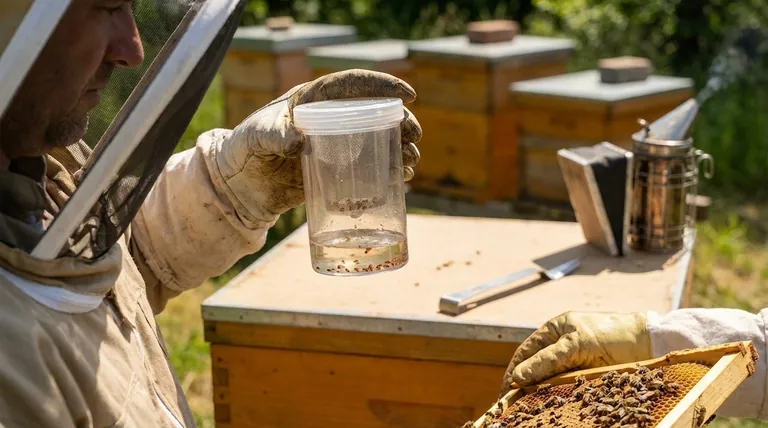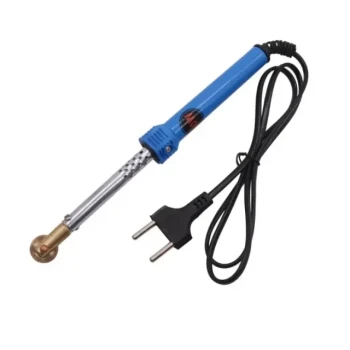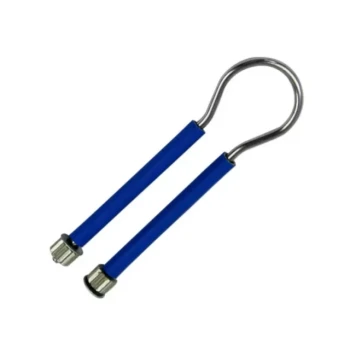In short, the varroa monitoring tool is a device designed to give beekeepers a quick, easy, and reliable way to count the number of varroa mites in a hive. This count provides a critical data point, known as the "mite load," which is essential for determining the health of the colony and deciding if treatment is necessary.
The true purpose of a varroa monitoring tool is not merely to count mites, but to empower the beekeeper with accurate data. This data transforms hive management from guesswork into an informed, proactive strategy to prevent colony collapse.

Why Varroa Monitoring is Non-Negotiable
The Threat of the Varroa Mite
The Varroa destructor mite is the single greatest threat to honey bee health worldwide. These parasitic mites attach to adult bees and developing brood, feeding on their fat bodies.
This feeding weakens the bees, shortens their lifespan, and, most critically, transmits a host of deadly viruses throughout the colony. An unmanaged infestation will almost always lead to the death of the hive.
Moving Beyond Assumptions
Without data, a beekeeper cannot know the true level of infestation. A colony can appear strong and healthy while harboring a rapidly growing mite population that will cause its collapse in a matter of weeks.
Regular monitoring provides a clear picture of the mite levels, allowing for timely and effective intervention.
How the Tool Works: The Alcohol Wash Method
The most accurate and widely recommended method for monitoring is the alcohol wash, and the tool is specifically designed to facilitate this process.
Step 1: Collecting the Sample
A sample of approximately 300 bees (about 1/2 cup) is collected from a frame of brood, avoiding the queen. These bees are placed into the tool's basket.
Step 2: Performing the Wash
Isopropyl alcohol is added to the container. The tool is then sealed and shaken for about 60 seconds.
The alcohol wash quickly kills the bees and the mites, but its primary purpose is to cause the mites to release their grip and fall off the bees' bodies.
Step 3: Counting the Mites
After shaking, the dislodged mites fall through the mesh of the basket and can be easily seen and counted against the bottom of the clear container.
This number is used to calculate the mite load, typically expressed as the number of mites per 100 bees. This percentage is then compared against established treatment thresholds.
Understanding the Trade-offs
The Cost: Sacrificing a Sample
The most significant trade-off of the alcohol wash method is that it is lethal to the sample of bees. This can be a difficult decision for many beekeepers.
However, the loss of ~300 bees is a negligible cost to a healthy colony, which can contain 30,000-60,000 bees.
The Benefit: Unmatched Accuracy
The sacrifice of a small sample provides the most accurate data possible. This accuracy is crucial for making responsible treatment decisions.
Inaccurate methods can lead a beekeeper to either treat a hive unnecessarily with chemicals or, far more dangerously, fail to treat a hive that is on the verge of collapse. The health of the entire colony depends on this reliable information.
Making the Right Decision for Your Apiary
- If your primary focus is accuracy: The alcohol wash is the gold standard and should be your method of choice for making critical treatment decisions.
- If your primary focus is colony survival: Regular monitoring with an accurate tool is the single most important action you can take to protect your bees from varroa mites.
- If your primary focus is responsible beekeeping: View monitoring not as a task, but as a fundamental part of understanding and managing the health of your hives.
Consistent monitoring transforms you from a reactive beekeeper to a proactive colony manager.
Summary Table:
| Purpose | Key Benefit | Key Trade-off |
|---|---|---|
| Provides accurate mite count (mite load) | Enables proactive, data-driven treatment decisions | Requires sacrificing a small sample of bees (~300) |
| Essential for colony health | Prevents colony collapse from Varroa destructor mites | Alcohol wash method is lethal to the sample |
| Transforms hive management | Moves beekeeping from reactive assumptions to informed strategy | Loss is negligible for a healthy colony of 30k-60k bees |
Protect Your Investment with Data-Driven Beekeeping
Don't leave your apiary's health to chance. Accurate varroa monitoring is the cornerstone of modern, responsible beekeeping, preventing costly colony losses.
HONESTBEE supplies commercial apiaries and beekeeping equipment distributors with the reliable, wholesale-focused tools needed for effective hive management. Our varroa monitoring equipment is designed for accuracy and ease of use, helping you make informed decisions that safeguard your colonies and your business.
Equip your operation with precision tools. Contact our team today to discuss your wholesale needs and build a more resilient apiary.
Visual Guide

Related Products
- HONESTBEE Professional Long Handled Hive Tool with Precision Cutting Blade
- Professional Dual-End Stainless Steel Hive Tool for Beekeeping
- Multi-Function Plier-Style Frame Grip Hive Tool
- Professional 3-Bar Frame Grip with Integrated Hive Tool
- HONESTBEE Professional Multi-Functional Hive Tool with Ergonomic Wood Handle
People Also Ask
- What are the basic tools for beekeeping? Essential Starter Kit for Safe & Successful Hive Management
- What is a hive tool and what are its uses? Master Your Hive Inspections with the Essential Beekeeper's Tool
- What is a hive tool used for in beekeeping? Your Essential Guide to Hive Management
- What are some common uses of a hive tool? Essential Multi-Purpose Tool for Every Beekeeper
- What is the hive tool used for? The Essential Multi-Tool for Every Beekeeper



















